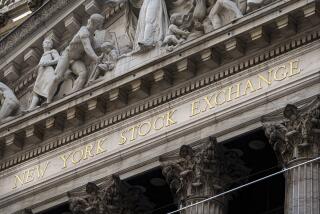Fed Intervenes to Provides a Lift for Sagging Dollar
NEW YORK — The dollar rebounded on Monday, pulling out of a recent slide, after the Federal Reserve intervened to prop up the currency when it hit a four-month low.
Since the start of October the dollar has slid about 7% against the Japanese yen and about 5% against the West German mark. Concern over the twin U.S. budget and trade deficits, as well as signs the economy is slowing, have weighed on the currency.
The Bank of Japan intervened when the dollar fell below a key support level in Asia, and the Federal Reserve later entered the market aggressively in New York to support the U.S. currency.
The central bank intervention got under way in Asia when the dollar fell under the key psychological level of 125 yen. The Bank of Japan bought $300 million to $400 million but the buying had little impact, and the dollar opened only slightly above its lows in New York.
Stability the Goal
But then the U.S. central bank stepped in, and this helped turn the dollar’s direction. The Fed intervened on three occasions, buying an estimated $200 million to $300 million for yen, according to currency traders. It was the first time the Fed bought dollars for yen since mid-April.
“This isn’t intervention to turn the tide of things but rather to restore some stability to the market,” said Stephen Leach, currency analyst at Chemical Bank in New York.
“The Fed sold Japanese yen and bought dollars,” said Renato Strauss, a trader at the New York branch of Bank Julius Baer & Co., a Swiss banking concern. “They made clear they were in the market.”
The Fed does not comment on its currency market activities, which are conducted via a select group of dealers.
But word gets out quickly when the Fed is buying or selling, either because dealers tell each other or because the size of a purchase or sale is so large it can only have been done by a large central bank.
The U.S. dollar also rose sharply against its Canadian counterpart. Fears on the part of Canada’s business community that Brian Mulroney’s Conservative government was losing support in the country’s Nov. 21 election campaign pushed the Canadian currency down nearly 1.5 U.S. cents to 81.58 cents.
Money traders said the market was shocked by a series of weekend polls showing a drop in support for the Conservatives. A loss for the Conservatives could very well spell defeat for the U.S.-Canada free trade pact.
Currency strategists were divided over the dollar’s longer-term trend. Many believe that the dollar will decline despite central bank intervention if pessimism about the U.S. economy intensifies. But others say the dollar already has declined significantly over the past few weeks and is due for a rebound.
James Chorek, a currency analyst at the commodities futures firm MMS International in Chicago, said he believed that the dollar would continue rising over the next few weeks, based on his calculations of supply and demand and other technical factors influencing its value.
“Overall to me, the dollar looks very good at this point,” he said. “It’s moving up against everything.”
Gains Against Pound
In Tokyo, the dollar fell 1.08 Japanese yen to 125.00 yen, but rose later in London to 125.45 yen. By the time trading ended in New York, the dollar fetched 125.67 yen, up from 125.63 yen late Friday.
The dollar strengthened against the British pound in London, where sterling fetched $1.7678, compared to $1.7680 late Friday. Later in New York, the pound traded at $1.7684, weaker than its $1.7720 value late Friday.
Other late dollar rates in New York, compared to rates late Friday, included: 1.7873 West German marks, up from 1.7719; 1.5074 Swiss francs, up from 1.4937; 1.2247 Canadian dollars, up from 1.2037; 6.0913 French francs, up from 6.0525, and 1,328.25 Italian lire, up from 1,319.25.
Other late dollar rates in Europe, compared to rates late Friday, included: 1.7810 West German marks, up from 1.7755; 1.4995 Swiss francs, up from 1.4970; 6.0800 French francs, up from 6.0750; 2.0000 Dutch guilders, down from 2.0010; 1,320.00 Italian lire, down from 1,321.50, and 1.2204 Canadian dollars, up from 1.2035.
Gold prices were narrowly mixed in U.S. trading after rising abroad. Republic National Bank of New York quoted bullion at $412.20 an ounce as of 4 p.m. EST, down five cents from its late Friday price.
On the New York Commodity Exchange, bullion for current delivery rose 30 cents to $412.70.
Earlier in London, gold rose 75 cents to $411.25; in Zurich, Switzerland, it rose $1 to $412.25; and in Hong Kong, it rose 18 cents to $414.46.
Silver for current delivery rose 1.4 cents an ounce to $6.303 on the New York Comex. In London, silver traded at $6.31, unchanged from Friday.
More to Read
Inside the business of entertainment
The Wide Shot brings you news, analysis and insights on everything from streaming wars to production — and what it all means for the future.
You may occasionally receive promotional content from the Los Angeles Times.










